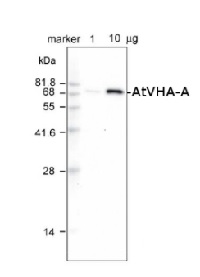1

Anti-V-ATPase, A | Vacuolar H+-ATPase subunit A (ammonium sulfate purified IgG)
AS09 467 | Clonality: Polyclonal | Host: Rabbit | Reactivity: A. thaliana, M. crystallinum, N. tabacum
Replacement: AS22 4814. Interested to receive a free sample? Contact us!
- Product Info
-
Immunogen: KLH-conjugated synthetic peptide derived from Arabidopsis thaliana V-ATPase subunit A, O23654, At1g78900
Host: Rabbit Clonality: Polyclonal Purity: Ammonium sulfate purified, total IgG. Format: Lyophilized Quantity: 100 µl Reconstitution: For reconstitution add 100 µl of sterile water. Storage: Store lyophilized/reconstituted at -20°C; once reconstituted make aliquots to avoid repeated freeze-thaw cycles. Please remember to spin the tubes briefly prior to opening them to avoid any losses that might occur from material adhering to the cap or sides of the tube. Tested applications: ELISA (ELISA), Western blot (WB) Recommended dilution: 1 : 8000 (ELISA), 1 : 2000 (WB) Expected | apparent MW: 68.8 | 70 kDa (Arabidopsis thaliana)
- Reactivity
-
Confirmed reactivity: Arabidopsis thaliana, Mesembryanthemum crystallinum, Nicotiana tabacum
Predicted reactivity: Chlamydomonas reinhardtii, Brassica napus, Cucumis sativus, Gossypium mexicanum, Hordeum vulgare, Oryza sativa, Ostreococcus lucimarinus, Phaseolus aureus, Populus balsamifera, Physcomitrium patens, Solanum lycopersicon, Triticum aestivum, Zea mays
Species of your interest not listed? Contact usNot reactive in: Thermotoga neapolitana - Application Examples
-
Application example

1 µg and 10 µg of crude membrane fraction/lane from Arabidopsis thaliana were separated on 12 % SDS-PAGE and blotted 1h to PVDF membrane (40 min. at 10 V using BioRad semidry transfer). Filters were blocked 1h with 5 % low-fat milk powder in TBS-T (0.05% Triton X.100). Membranes were washed 5 times with TBS-T, each time in a fresh polystyrene box and probed with anti-V-ATPase subunit A antibodies (AS09 467, 1:2000, 1h) and secondary anti-rabbit (1:2000, 1 h). All steps were performed in RT with agitation.
- Additional Information
-
Additional information: 0.1 % sodium azide is added as preservative. For antibody re-suspending information check the tube label.Antibodies will detect target protein in a few µg of a crude preparation loaded per well. If purified preparations of vacuolar and plasma membranes are used, one µg load per well should be sufficient.Protocol for isolation of plant vacuolar membranes can be found here.Additional information (application): Protein or membrane sample should be treated at 70°C for 10 min before loading on the gel.Diluted antibody solution can be used 2 to 3 times within one month if it contains 0.1 % sodium azide as preservative and is stored at -20ºC to -80ºC. - Background
-
Background: V-ATPase subunit A is a catalytic subunit of V1 complex of vacuolar ATPase. This enzyme (EC=3.6.3.14) is involved in acidification process of various compartements of eucaryotic cell. This protein is coded by VHA-A gene. Alternative names: Vacuolar proton pump subunit alpha, vacuolar H(+)-ATPase subunit A, V-ATPase 69 kDa subunit
- Product Citations
-
Selected references: Vera-Estrella et al. (2017). Cadmium and zinc activate adaptive mechanisms in Nicotiana tabacum similar to those observed in metal tolerant plants. Planta. 2017 Apr 28. doi: 10.1007/s00425-017-2700-1.
Barkla et al. (2016). Single-cell-type quantitative proteomic and ionomic analysis of epidermal bladder cells from the halophyte model plant Mesembryanthemum crystallinum to identify salt-responsive proteins. BMC Plant Biol. 2016 May 10;16(1):110. doi: 10.1186/s12870-016-0797-1.
Yoshihiro et al. (2006) Immunochemical analysis of aquaporin isoforms in Arabidopsis suspension-cultured cells. Cells. Biosci.Biotechnol. Biochem. 70: 980-987. - Protocols
-
Agrisera Western Blot protocol and video tutorials
Protocols to work with plant and algal protein extracts
Agrisera Educational Posters CollectionMethod for isolation of plant vacuolar membranes
.jpg)
Courtesy of Dr. Masayoshi Maeshima, Laboratory of Cell Dynamics, Graduate School of Bioagricultural Sciences Nagoya University Nagoya, Japan
- Reviews:
-
This product doesn't have any reviews.
Accessories

AS07 213 | Clonality: Polyclonal | Host: Rabbit | Reactivity: Higher plants including A.comosus, A.thaliana, C.sativus, C. australis R.Br, C.reinhardtii, F. margarita Swingle, H.vulgare, L.esculentum, L.longiflorum, Malus x domestica Borkh. c.v. Fuji, M. truncatula, M.crystallinum, N.tabacum, N.caerulescens, O.sativa, P.hybrida cv. Mitchell, Populus sp., P.vittata, Thellungiella sp., T. aestivum, Z.mays, V. vinifera | Cellular [compartment marker] of tonoplast membrane

